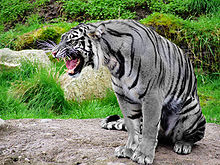- Maltese tiger
-
The Maltese tiger, or blue tiger, is a sub species coloration morph of a tiger, reported mostly in the Fujian Province of China. It is said to have bluish fur with dark grey stripes. Most of the Maltese tigers reported have been of the South Chinese subspecies. The South Chinese tiger today is critically endangered, and the "blue" alleles may be wholly extinct. Blue tigers have also been reported in Korea, home of Siberian tigers.
The term "Maltese" comes from domestic cat terminology for blue fur, and refers to the slate grey coloration. Many cats with such colouration are present in Malta, which may have given rise to the use of the adjective in this context.
Contents
Sightings
Around 1910, Harry Caldwell, an American missionary and big game hunter, spotted and hunted a blue tiger outside Fuzhou. His search is chronicled in his book Blue Tiger (1924),[1] and by his hunting companion Roy Chapman Andrews in his Camps & Trails in China (1925, chapter VII).[2] Chapman cites Caldwell thus:
The markings of the beast are strikingly beautiful. The ground colour is of a delicate shade of maltese, changing into light gray-blue on the underparts. The stripes are well defined and like those of the ordinary yellow tiger.—Caldwell, Chapman (1925)A more recent report, given to Mystery Cats of the World author Karl Shuker, comes from the son of a US Army soldier who served in Korea during the Korean War.[dubious ] His father sighted a blue tiger in the mountains near what is now the Demilitarized Zone. Blue tigers have also been reported from Burma.[citation needed]
The black tiger was also long considered mythical, but several pelts have proven that pseudo-melanistic or hypermelanic tigers do exist. They are not wholly black, but have dense, wide stripes that partially obscure the orange background colour. [3]
Genetics
- See also: Cat coat genetics
In support of the blue tiger theory, Maltese-colored cats certainly do exist. The most common are a domestic cat breed, the Russian Blue, and a variety of the British Shorthair, the British Blue, but blue bobcats and lynxes have also been recorded, and there are genetic mutations and combinations that result in bluish hue, or at least in the impression of a blue-gray animal. Shuker suggested that blue tigers possessed two different pairs of recessive alleles - the non-agouti (s/s), and the dilute (d/d)[3] which combine to produce a solid blue-gray colour as found in domestic cats such as the British Blue and Russian Blue, but would not produce the striped blue tigers reported.
Simply combining non-agouti and dilute alleles would probably indeed result in a greyish or "maltese" tiger, but such an animal would have hardly-visible stripes or none at all: Normal tigers switch between agouti (orange) and non-agouti (black) in different areas of their pelage, as well as suppressing melanin production thoroughly (white). The non-agouti mutation would produce animals similar to black panthers which have only a "ghost" pattern, all hair being black but the hairs of their rosettes retaining a different texture and thus, "black-on-black" rosettes are visible under appropriate lighting. Combined with all-dilute alleles, the color would be grey, but it would still result in an unstriped or ghost-striped tiger.
For a Maltese-and-striped fur, pheomelanin production must probably be suppressed (to switch from an orange to a greyish color) but agouti retained (to yield darker stripes); perhaps some hypermelanism would also be present, to produce an animal with a non-white belly as reported by Caldwell. Indeed, such a genotype is known in cheetahs, where it produces animals that are bluish gray with dark slate grey pattern. If factors such as lighting conditions are accounted for, this makes a reasonable match with Caldwell's individual.
A variant expression of the non-inhibited pigment ("chinchilla ") allele - the allele in other contexts producing white tigers - is also sometimes deemed possible. This would produce a "haze" effect over the whole body. Combined with a pheomelanin suppression, it would produce a white animal with light gray pattern; such specimens are also known in the Cheetah.
Possible distribution
In small or isolated populations, genetic drift can fix unusual traits such as aberrant coloration. A non-harmful mutation can soon become widespread in small, isolated populations. Moreover, if the mutant gene confers benefits, such as better camouflage, then affected individuals may out-compete those without the mutation; this would happen faster in a small inbred population close to panmixia.
References
- ^ Caldwell, Harry R (1924). Blue Tiger. Abingdon Press.
- ^ Chapman Andrews, Roy (1925). Camps & Trails in China: A Narrative of Exploration, Adventure, and Sport in Little-Known China. Appleton. HTML fulltext at Project Gutenberg
- ^ a b Shuker, Karl P N (1989). Mystery Cats of the World. Robert Hale. ISBN 0-7090-3706-6.
External links
- Maltese tiger article at Cryptozoology.com
- "Rare Indian tigers spotted at Simlipal, The Hindu, June 4, 2007
- Maltese tigers at MessyBeast.com
Categories:- Tigers
- Carnivorous cryptids
Wikimedia Foundation. 2010.


